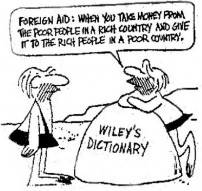5.2. Foreign Aid to India

♤ The term “foreign aid” is derived from the concept of “Overseas Development Assistance” or ODA. In UN parlance ODA is a commitment assumed by developed countries, members of the OECD, to extend development assistance to developing countries. Currently, developed countries are committed to transferring 0.7% of their GDP as ODA to developing countries, though few have achieved this target.
♤ The India was the sixth largest recipient of foreign aid in 2011 and continues to be one of the highest recipients. According to the data on World Bank’s website, it received $3.2 billion in 2011, $1.6 billion in 2012 and $2.4 billion in 2013.
♤ The top donors have been- World Bank, Japan, Germany, Asian Development Bank, United Kingdom, France, Global Fund (to fight AIDS, tuberculosis and malaria), United States and European Union.

♤ India has also been giving aid to other countries. It has
a foreign aid budget of $1.6 billion for the period 2015-16.
♤ However in recent times foreign aid coming to India has declined significantly. It partly due
to India’s rapid economic progress and partly due to ever-changing geo-political axis.
♤ U.S. aid to India, targeted toward clean energy, food security and health, has dropped 25 percent in recent years, from nearly $127 million in 2010 to a proposed $98.3 million in 2013.
♤ In 2015, UK stopped giving aid to India owing to it’s economic growth. Indian government
welcomed the move by suggesting that ‘aid is past, trade is future’.
♤ India now sees – and projects – itself as a global power and a partner to developed nations like Britain, rejecting the traditional model of rich nations aiding poor ones.
